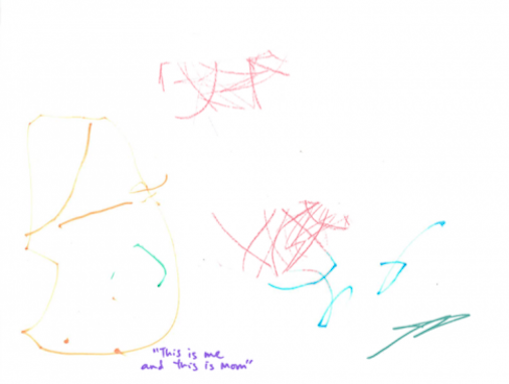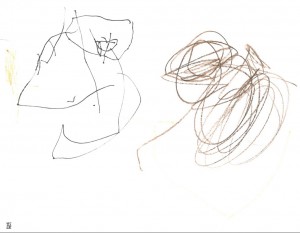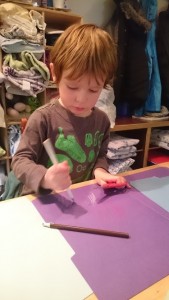
“Look at my picture!”
by Cassie Tondreau, Educator, Hilltop Children’s Center
Have you ever seen a child furiously scribbling on paper and narrating as they go? It can sound something like this: “I’m making a big truck, it has big wheels and a driver-‘Beep! Beep!’” or “This is a party and everyone is dancing. Look at their long dresses!” Looking at the mess of wild lines, it’s hard to imagine any connection between what your child is drawing and what they are saying. Appearances can be deceiving!
At Hilltop, we notice a great deal of connection between children’s words and drawings, in fact the act in itself is a way of connecting words with pictures. As educators and parents, we have many tools to help cultivate this skill.
Children gain a great deal of skill from drawing. Their fine motor skills are refined by grasping a crayon or pencil, as well as hand-eye coordination. These skills lend themselves to the creative pursuit of creating art, and all of the joy that goes with it.
“By providing children with the materials and opportunities to scribble we can promote physical skills. Just as babbling is a natural way to gain language, scribbling is a natural gateway to muscle control and coordination. In fact, Cratty (1986) termed scribbling “motor babbling.”
from When Children Draw by Sandra Crosser, Ph.D.
As they draw, children think of their surroundings, books or media they know and love, as well as people they know. Their drawings can reflect a wide span of time in their memory, often showing something remembered from a long ago vacation or trip to the zoo that parents would have otherwise thought would be forgotten. They can also reflect concepts a child is attempting to grasp, such as where an animal sleeps outside, or the wheels of a train connecting to a track.
When you are with a child – at home or in your work – you can help extend the valuable improvisation and fun of scribbling. Feel free to join in, enjoying the fun behind fast, jagged lines, slow, loopy lines, and all the other lines in between. Remember that a child’s ideas about their drawing can change as they scribble, so go with their ideas even if they seem to be jumping from idea to idea. If they want to stop drawing very quickly, try bringing their attention to a certain spot on the drawing, thinking out loud as you do: “I wonder what kind of lines you’ll make next. I have some different colors, where should they go?” As tempted as we may be to look for an image in the drawing, it’s important to remember that labeling work a child creates can limit them. Bringing their attention to one area or color in the drawing and saying “Tell me about this,” or asking “Why did you choose that color?” can lead them back to the thinking that began the drawing.
Drawing can be an amazing way to get insight into a child’s way of thinking and seeing the world. It’s important to remember that the action of drawing, and the catharsis of creating art can be just as important as “drawing a picture,” and certainly just as valuable an endeavor for a child. Enjoy the process, and remember that the process is the goal in beginning a relationship to art.
[author] [author_image timthumb=’on’]https://hilltopcc.com/wp-content/uploads/2014/12/Cassie.jpg[/author_image] [author_info]Cassie Tondreau is an Educator with two- and three-year-olds at Hilltop Children’s Center, where she has worked since 2011.[/author_info] [/author]
1 thought on ““Look at my picture!””
Comments are closed.

This definitely resonates with me, Cassie, and I’m grateful for your observations. I sometimes beat myself up because I can’t write down everything the child is saying in the moment… and then feel less excited about it when I present it to parents. But I also want to remind myself that just presenting the finished product can sometimes dismiss the experience and the narrative that did exist for the child — even if I couldn’t perfectly document it! I am trying to tell the parents the “story” piece first, then, if the child wants to show them, move to the artwork as a by-product. The growth is happening in the art process, right? So reflecting with children and families afterward must come with a deep respect for that process, too. Thank you for helping us recognize all that’s important about these “wild lines”!